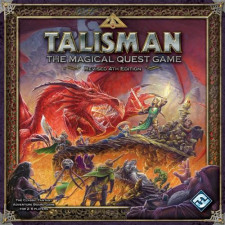Talisman: Revised 4th Edition Review
on Feb 2, 2016

Kyle: 
KM: You can’t really talk about adventure games for any length of time without eventually finding your way back to Talisman. In a lot of ways it is the grandfather of the whole genre, though it does find its own roots in fantasy roleplaying games popular when it was conceived. At the same time, the game grafts in a lot of board gaming tropes like roll-and-move and drawing random cards to see what fate befalls you, and even brought some interesting ideas to the table that designers are still drafting off today.
NO: Talisman is rightly considered a classic in adventure gaming, but if you bring it up in certain circles you will get some sideways glances. For some it represents the pinnacle of bad design, and I doubt it would pass muster with most modern designers. But there is something elemental, almost pure, about its single-mindedness. Its beauty is in its simplicity. Games are a constant pull between our head and our hearts, and how those two things feed into each other. Talisman is the sort of game that operates on an almost totally emotional level, but it does so because the design is so straightforward.
KM: For me, I think the greatest strength of Talisman is its ability to weave stories with a genuine arc. While a lot of games have since thrown their hats into the “story generation†genre, most of them just have wild things happening to you. You read some flavor text on a card and move on. What’s really neat about Talisman is that you actually feel the progression of the character, from a lowly nobody setting out on a fantastic journey to the tipping point where you bite the bullet and set off to the dangerous finale in search of glory. The characters go forth on their personal journey, with hearts set on nothing but fame and fortune, as all the best sword and sorcery “heroes†have. There’s no pandemic or invasion or growing darkness to confront; just show me the treasure!
NO: If it’s not obvious already, I think Talisman is one of the best games ever designed. As far as I’m concerned it’s the ideal adventure game. Obviously you like it as well Kyle, but in a much more measured way. I find it interesting that you talk about the character progression, because I’ve never thought about that. It happens, but in-game it feels almost like an accident. That’s probably how real adventurers feel.
KM: That’s a great point. There is no clever leveling up minigame or tacked-on subsystem to make character growth work. It’s simple, and mechanically you hardly notice it, but it really does drive the progression of the game forward in an interesting, tangible way. At the beginning of the game, a puny thief is beating you bloody and leaving you for dead on the side of the road, but just a few hours later, you barely need to roll your die to beat a fire-breathing dragon.
Now you sensed that I’m a little more lukewarm on it, and I’d say that’s accurate. I like a good round of Talisman, but for me the game’s length tends to outpace its enjoyment factor. It’s a child of its time, an era where you could get friends together and just play for a whole Saturday, and there wasn’t a whole stack of new shiny games to distract anyone. I don’t hold that against it, but it does mean that when hour 3 of Talisman hits, my eyes start to wander to that other game stack.
NO: Well, the length is a common complaint, and it’s not unreasonable. It’s not that Talisman always takes several hours, but like a lot of older designs there is nothing in the game driving you toward the finish line. The players decide when they are ready for the game to end. It’s true it will take a couple hours to get to a point where that’s possible, since you need to spend time adventuring around the board and beefing up. But the entire game revolves around how early you think you can make that leap deeper into the board, and it’s probably earlier than you think. There are a couple of tweaks I recommend to shorten the game (most of all, lower the threshold to upgrade from seven points of trophies to five), but that won’t make it a quick game you can pound out in 45 minutes. Still, if your games are routinely going for six hours, you probably aren’t very good at Talisman.
KM: Oh, I totally agree with that. Even when the supposedly shorter Relic came out, people immediately hopped online and started complaining their games were going five or six hours, and I couldn’t believe it, since my sessions were topping off at a little over two. As it turns out, the big difference was they were all maxing out their characters before going toward the middle! And it’s the same thing in Talisman: the players need to remember it’s a race. Still, unless you apply some of the tweaks you mentioned, it’s a little too drawn out for me.
NO: I find something about the length kind of meditative. Because of its simplicity it evolves into a rather social game. You laugh at other people’s misfortune, chat about other stuff between turns, pass around the snacks. In most games stuff like that pulls away from the session, but Talisman is the sort of game that can continue even while all this stuff is going on. It plays a lot better in very social groups rather than structured cerebral ones, and the length gives those things some room to breathe.
KM: Well, I can accept that game length is more my own tastes and inability to pay attention than any fault in the design. But what’s a worse offense to me is that for all the imagination and flavor stuffed into that box, they couldn’t come up with anything better than a bland, Monopoly-inspired board. I’d kill for a redesign with a map that makes sense, with believable geography and meaningful spatial relationships among the different locations (I can’t believe FFG didn’t even remedy this in Relic). As it is, all too often I’m sucked out of the zany world of Talisman and brought back down to earth, where I’m sitting in an uncomfortable chair staring at a ziggurat of concentric rectangles. It probably bothers me more than it should.
NO: One key thing to remember about Talisman is that while it is theoretically a “hobby game†it has one foot firmly in the mainstream. I think the board is a reflection of that, and I do understand how that would be considered abstract. But it allows for some really cool visual cues that make different stages in the game a big deal. There’s that seemingly impassable river between the outer and middle regions, and the imposing Portal of Power before players push into the inner region. I’m not sure how one could cut off chunks of the board to weaker players and still give a feeling of openness without using concentric rectangles. Besides that, I think it’s more intuitive and immediate. Everyone understands the flow of the game instantly, because everyone has seen it used in games like Monopoly. I don’t think a different map would be much harder, but there’s basically no need to explain it at all in its current form.
KM: That’s a good point I hadn’t considered before, and maybe it’s worth the eroded sense of immersion to get everyone playing immediately. That’s probably where a lot of adventure games start to lose new gamers, in their piles of mechanisms and design decisions honed to appeal to the hardcore. It is very refreshing to play a game that does not apologize for its simplicity.
NO: Let’s talk about the big thing that comes up whenever I discuss Talisman: the luck. Everything in this game is governed by a die roll, and what isn’t revolves around a card draw. Some people really hate the roll-and-move aspect especially. I’ve heard all sorts of variants that give players more choice than just the binary one to move left or right, like allowing them to move up to the value on the die instead of the whole place. I think the luck in Talisman actually contributes to what makes the game special. Unlike most modern designs, Talisman doesn’t really care about the player. Certain parts of the board are more hazardous, but it has no problem throwing a too-big monster at you early. It doesn’t use kid gloves on you, and the luck makes everything on the board feel like a risk. Unless your character is just that strong, there’s a chance you could fail, and a chance that failure could be catastrophic. It doesn’t feel safe, but actually feels, well, adventurous.
KM: Yes, it’s wonderful that Talisman does not hold your hand. Those variants people post drive me batty: “Roll three dice and pick which one you want.†Just go play a worker placement game already! These kinds of changes to the rules miss the whole point of the game: you’re wandering around an uncharted land. Maybe you’re trying to get to the town, and you know generally where it is, but it’s not as if you have Google Maps to help you, so you overshoot it and end up wandering a dark forest where you stumble upon a witch’s lair. The narratives generated by the dice and cards working in tandem provide the real draw of this game, and fiddling with that distills the purity of the story.
What’s more, the roll-to-move mechanism, while out of favor today, has one often overlooked strength: the briskness of play. Roll a die, move, encounter, next player. I’ve played most of the Talisman wannabes over the years, and they all try to one-up the classic by providing lots of movement choices. The problem is, they all take forever to play and have considerable downtime issues as players sit there and mull over all their options. These takes on the adventure genre really tend to miss the heart of what Talisman was all about: a cold, unforgiving land where you might find great fortune or meet a horrible end. And it wasn’t really ever up to you.
NO: That’s a great insight into why Talisman still matters, and why it’s one of the most important hobby games. It’s spawned a ton of look-alikes and imitators, many of which have a lot to recommend them. But none of them have really been able to supplant Talisman. It’s certainly an influential game, but it’s also one that strikes a chord with players. As of this writing, it has thirteen expansions, with a fourteenth on the way, which shows just how resonant it is. All that dice-rolling and random movement creates a game about conquering the unknown. The player has no choice but to be brave and dive in. That’s what adventures are all about.

 Customer Support
Customer Support  Subscribe
Subscribe 




 Account
Account  Wishlist
Wishlist 

